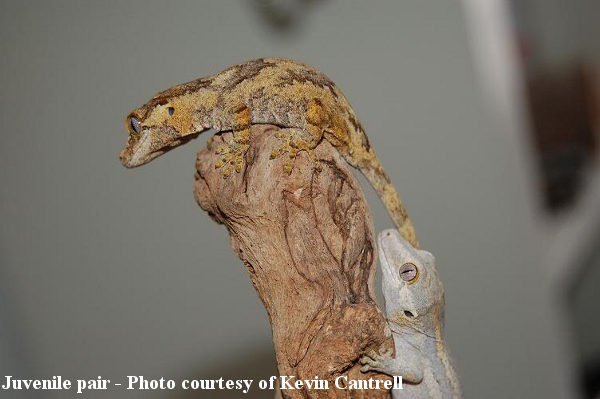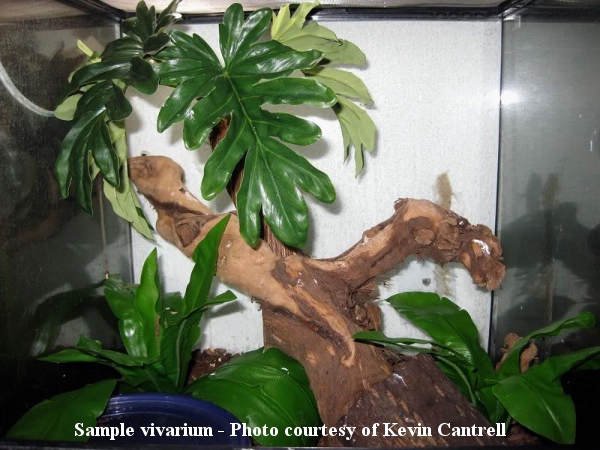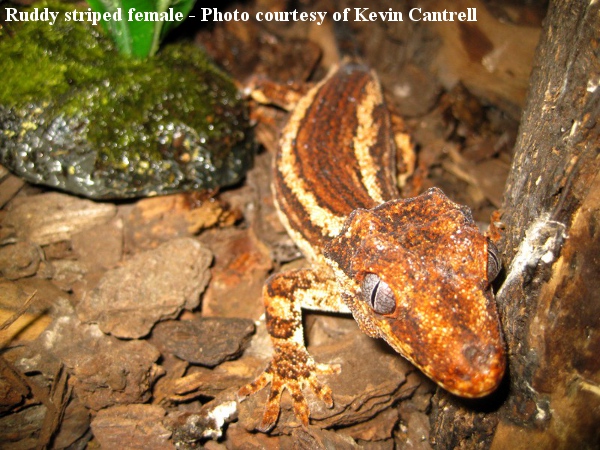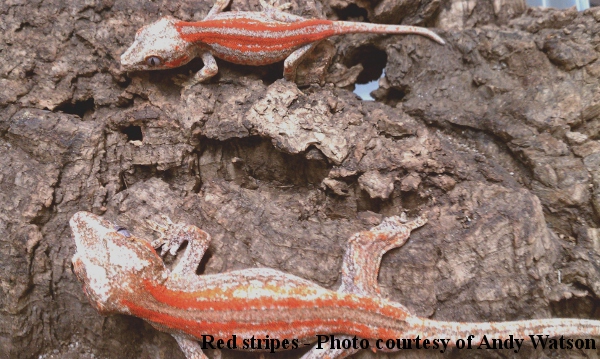Rhacodactylus auriculatus, or Gargoyle Geckos, are a robust arboreal species native to the Island of New Caledonia. These geckos have a portly build, semi-prehensile tail, and two distinct knob-like structures or “horns” atop their heads that give them their name. They are currently classified in the genus Rhacodactylus along with other geckos that you may know, including crested geckos (Rhacodactylus ciliatus) and giant geckos (Rhacodactylus leachianus). Auriculatus, or “aurics” or “gargs” for short, have been in the hobby longer than either ciliatus or leachies, but did not truly gain popularity until the crested gecko phenomenon caught on. In relationship to cresteds, gargs have a similar diet, similar habitat and similar care requirements so they are a natural choice for someone looking to get their second or third gecko if they are already keeping cresteds. For those who are considering getting a garg as a first gecko, they are also a great choice.
[ad#sponsor]
The care of aurics is simple and straightforward. I will go into brief detail on feeding, watering, housing and breeding of this delightful species.
Housing
Auriculatus are arboreal geckos that inhabit the lower portion of the forest and spend more time at floor level than their other Rhacodactylus relatives. This should be taken into consideration when setting up a vivarium for them. I have found that my gargs tend to like more length and width in their terraria than height. I’m not saying that height is not important, as these are technically arboreal geckos, but that while you might choose an 18”x18”x24” tank for a crested gecko, for a garg a wiser choice might be an 18”x24”x18” tank. Minimum tank size for 1 adult is 10 gallons, but 20 gallons or larger is preferred.
No matter what size tank you choose to employ, the set up should be almost the same. Gargs are heavy bodied geckos and require large, secure logs and or branches to climb on and large leafed plants that can support their weight. For my gargs I use a variety of thick vines (found at reptile shops or online), grape wood pieces (found at many reptile shops or garden centers) and cork bark tubes and flats (easily found at reptile stores or online). For foliage, I prefer live plants, but there are also some high quality fake plants on the market now. Some of the plants that I use for my gargs are Pothos, Philodendron, Sansevieria (snake plant), and Asplenium (bird’s nest fern). For a substrate you can use orchid bark, coco fiber or soil. I prefer orchid bark to prevent females from laying eggs directly into the substrate.
Temperature
Gargs come from New Caledonia, where the temperature stays relatively mild year round, so typical house temps are fine. I keep mine at an ambient of 76-82F day and 68-72F night almost year round. A slight temperature drop during the fall/winter period can help induce breeding and give females a break from laying eggs. During the winter my New Caledonian geckos are cooled down to around 68F day and 62F night. I do provide a low wattage basking light during the day for all of my adult auriculatus and most of them can be seen out basking during the day from time to time. A simple 15-25 watt incandescent bulb will work fine without raising the temps up too much, but I prefer to use 13 watt compact fluorescent bulbs or CFLs as they add lots of nice light and don’t put off much heat.
Feeding/Watering
Gargoyle geckos are insectivorous and frugivorous, meaning they eat both insects and fruits/nectars in the wild. They also have been known to eat young birds and other reptiles, so housing them with other species or even other gargs of a different size is not recommended. Food can be in the form of insects, powdered meal replacements or home made fruit purees and should be offered at least 3 times per week. Suitable insect prey can include crickets, roaches, and various worms – all appropriately sized, of course. Powdered meal replacements such as Repashy’s CGD (crested gecko diet) or Clark’s FGD (frugivorous gecko diet) are easy to use and well liked by these geckos. No matter what you are feeding them, make sure you are using a high quality vitamin and mineral supplement, such as Sticky Tongue Farm’s Miner-All and Vit-All, at least every third feeding.
Water should be on hand at all times in a clean water bowl and should be changed daily. Water should also be provided at least once per day in the form of misting. This can be done with a small hand held spray bottle or larger commercial misting systems. Misting the cage provides the necessary humidity for these tropical geckos and also provides drinking water as well.
Breeding
Breeding of gargoyle geckos is fairly simple and similar to that of crested geckos. Breeding groups can consist of one male and several females, but I prefer to keep mine in pairs. Never house 2 males together, especially if there are females present as fighting will occur. The geckos should be at least 18 months old and of good size/weight before being introduced for breeding. At this age, as long as all care requirements are being met, they should start breeding on their own with no extra work needing to be done by the hobbyist. Eggs are laid directly into the substrate or in a nest box from spring to fall and hatch after 60-90 days depending on temps. I incubate my eggs at room temps from 80F day down to as low as 70F night. For an incubation substrate you can use perlite, vermiculite or Repashy’s clay based Super Hatch. It is important to make sure that breeding females are getting enough calcium during the egg laying season. This can be done by adding a high quality calcium powder into their fruit or by dusting it onto feeder insects.
Care of Juveniles
Young gargoyles are very easy to care for and can be kept exactly the same as adults, only on a miniature scale. I house mine in large kritter keepers with paper towels as a substrate and some fake plants and a few thin branches. I keep only 2-4 juvenile aurics per rearing tank, as they can grow fast and some will start eating the tails of the others. Food and water should be offered daily for these little devils. I also offer them more live prey than I would a juvenile crested gecko, or even an adult garg, as they seem to need the added protein.

Morphs, Forms and the Future
There are several morphs or color phases of gargoyle geckos in the hobby and at least a few pattern variations. I’ll start with the pattern types. As of right now there is the standard granite or reticulated form, a wild type or banded form, a striped form, and an aberrant or mosaic form. All of these can also come in different color morphs as well. The color morphs that have popped up thus far are wild type or ‘ruddy’, black and white, red background, red blotched/striped and orange blotched/striped. Also in the hobby are a few yellow, salmon and pink blotched/striped aurics, as well as at least one or two melanistic specimens. There is even a new black eyed, or “phantom eyed” form that is starting to establish itself in captivity. In the next few years I feel we will see some exciting new gargoyle geckos in the hobby and I hope to be on the cutting edge of it.
[ad#250]






These are probably my favorite arboreal geckos and I am expecting quite a few babies this year as well. Thanks for the great article. Hopefully more people realize how awesome these geckos are.
Thanks for the great article on gargs, along with their care and breeding. Love the pics. I agree they would make a great pet as your first gecko.
This articles makes thinks very easy to grasp.. good writing btw
my first gecko was a gargoyle gecko and i love her i would defiantly recommend one to any one interested. great article btw
In fact gargoyles live mostly in shrubland near forest or in the fringes of the forest. For that reason they are the most common new caledonian gecko a human can find. They also have the broadest diet of any gecko studied, with insects, snails, small lizards, fruits, nectar and other plant parts included. I wonder why all this information isn’t put to use in its captive husbandry, and it is still kept like a kind of crested gecko. Also, I heard they can tolerate higher temperatures. Being from outside the forest, that makes sense. But what is your experience about that?
Bolko,
You’re spot on about all of those things. The only reason I left them out of this article is because I was trying to streamline it for the average, entry level reader.
I personally keep my auriculatus warmer than my ciliatus, and offer basking lights and more live prey items.